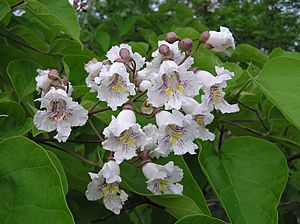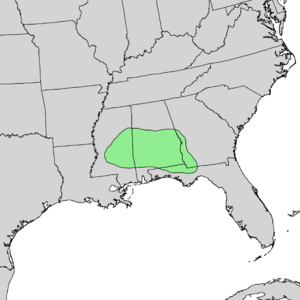Southern catalpa facts for kids
Quick facts for kids Southern catalpa |
|
|---|---|
 |
|
| Conservation status | |
| Scientific classification | |
| Genus: |
Catalpa
|
| Species: |
bignonioides
|
 |
|
| Natural range of Catalpa bignonioides | |
The Catalpa bignonioides, also known as the Southern Catalpa, is a type of tree. It is native to the southeastern United States, growing naturally in states like Alabama, Florida, Georgia, Louisiana, and Mississippi. People also call it the cigartree or Indian-bean-tree because of its long, thin fruit.
Contents
What is a Southern Catalpa?
The Southern Catalpa is a medium-sized tree that loses its leaves every year. It can grow to be about 15 to 18 meters (around 50 to 60 feet) tall. Its trunk can be up to 1 meter (about 3 feet) wide. The bark is brown to gray and becomes rough as the tree gets older. This tree has strong, deep roots and branches that can break easily.
Leaves of the Catalpa Tree
The leaves of the Catalpa tree are very large and shaped like a heart. They are usually 20–30 cm (8–12 inches) long and 15–20 cm (6–8 inches) wide. These bright green leaves appear late in the spring. They are fully grown even before the flowers open, making the tree look very beautiful.
A cool fact about Catalpa leaves is that they make nectar. This is unusual for leaves! They have tiny glands that produce this sweet liquid.
Catalpa Flowers
The flowers are shaped like trumpets and are about 2.5–4 cm (1–1.5 inches) wide. They are white with yellow spots inside. These flowers grow in large clusters of 20 to 40 blooms. In the northern parts of the USA, the Catalpa is one of the last trees to bloom. It shows off its big white flower clusters in June or early July. These flowers are so many that they almost hide the leaves!
Each flower has purple and gold spots inside. These spots often form lines that lead insects directly to the nectar. The flowers have both male and female parts. However, they are designed to avoid fertilizing themselves. The female part of the flower stays closed until after the male part has released its pollen and withered. This way, the flower waits for a bee to bring pollen from another flower.
Catalpa Fruit and Seeds
The fruit of the Catalpa tree looks like a long, thin bean pod. It is about 20–40 cm (8–16 inches) long and 8–10 mm (about 0.3 inches) wide. These pods often stay on the tree all winter long. Inside the pod are many flat, light brown seeds. Each seed has two papery wings, which help them fly away in the wind.
The Southern Catalpa is very similar to the Northern Catalpa (C. speciosa). You can tell them apart by their flower clusters. The Southern Catalpa has more, but smaller, flowers. Its seed pods are also a bit thinner.
How Catalpa Trees Protect Themselves
Catalpa trees have a clever way to protect themselves from insects that want to eat their leaves. When a caterpillar, like the Catalpa sphinx caterpillar, starts munching on a Catalpa leaf, the leaf produces extra nectar. This extra nectar attracts more "bodyguard" ants to the damaged leaves. These ants then help protect the whole plant from other hungry insects. This is a great example of a symbiotic relationship, where the tree and the ants help each other.
Where Catalpa Trees Grow
The Southern Catalpa tree is truly a tree of the Southern United States. The Cherokee Native American tribes were among the first to notice this tree growing in their fields. They called it "Catalpa."
Even though it started in the South, the Catalpa tree can grow almost anywhere in the United States and even in southern Canada. It has spread widely and now grows naturally in many places outside its original home.
Growing and Using Catalpa Trees
The Southern Catalpa is a very popular tree for planting in gardens and parks. It has some of the most beautiful flowers of all American native trees. People around the world love to plant it in their parks and gardens. A special type with gold leaves, called C. bignonioides 'Aurea', has even won an award for being a great garden plant.
This tree likes wet soil and lots of sunshine. It's easy to grow from seeds, which sprout quickly. You can also grow new trees from cuttings. Catalpa trees are quite strong and usually don't get many diseases or insect problems.
The wood of the Catalpa tree is strong and doesn't rot easily. Because of this, it's often used for things like fence posts and railroad ties.
Catalpa trees contain natural chemicals that keep most plant-eating insects away. However, the Catalpa sphinx caterpillars are special. They can eat Catalpa leaves without getting sick. In fact, they even store these chemicals in their bodies! These caterpillars can eat a tree's leaves several times in a summer, but the tree usually recovers. People who like to fish often collect these caterpillars to use as bait, especially for catfish. They can even freeze them to use later!
The Southern Catalpa is also one of the parent trees of a special hybrid tree called × Chitalpa tashkentensis. This new tree was created by a scientist in Uzbekistan. The hybrid tree is sterile, meaning it cannot produce seeds.
History of the Catalpa Tree
The Catalpa genus used to be common in Europe a very long time ago, during the Tertiary period. Scientists have found fossil remains of Catalpa trees in rocks from the Miocene period near the Yellowstone River.
See also
 In Spanish: Catalpa bignonioides para niños
In Spanish: Catalpa bignonioides para niños





